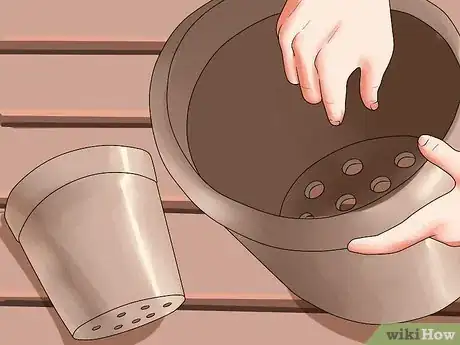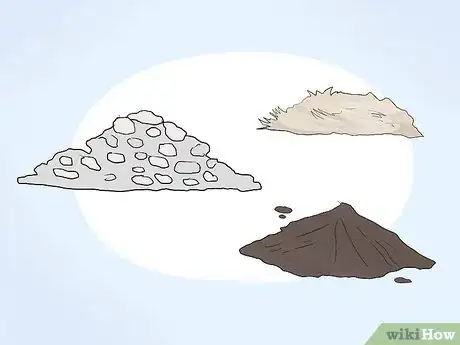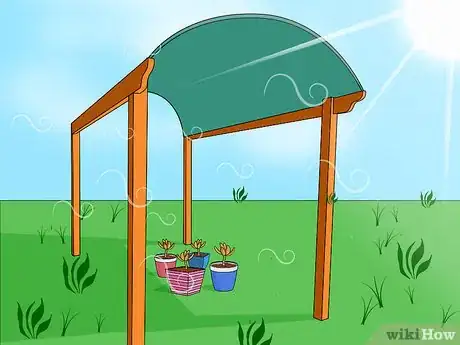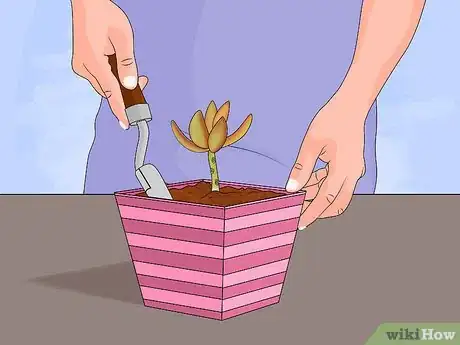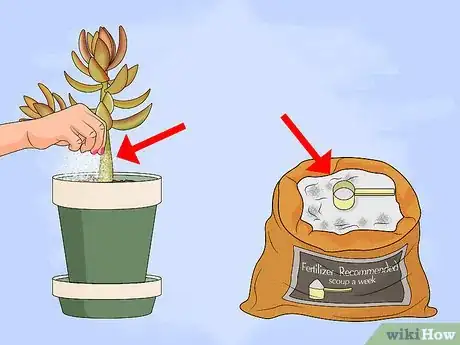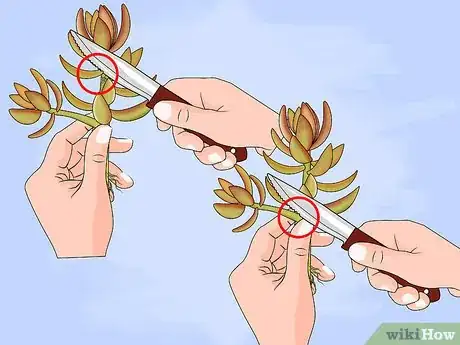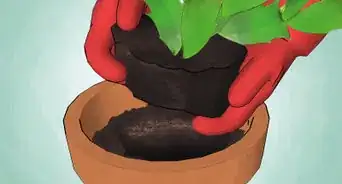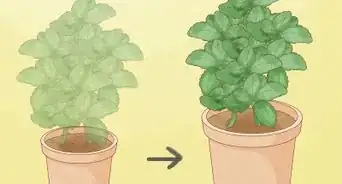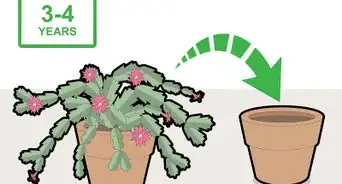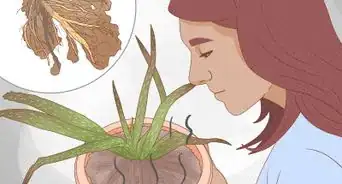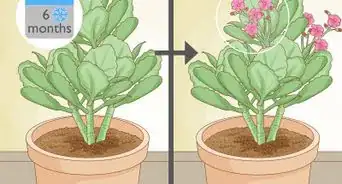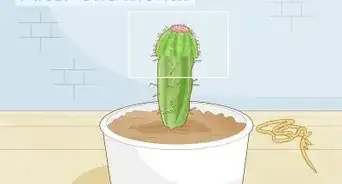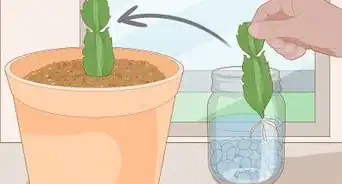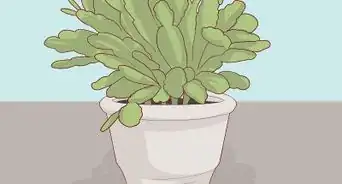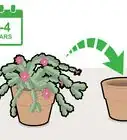wikiHow is a “wiki,” similar to Wikipedia, which means that many of our articles are co-written by multiple authors. To create this article, 9 people, some anonymous, worked to edit and improve it over time.
wikiHow marks an article as reader-approved once it receives enough positive feedback. In this case, 93% of readers who voted found the article helpful, earning it our reader-approved status.
This article has been viewed 35,771 times.
Learn more...
Succulents are plants with parts that are thick and fleshy, usually to retain water in arid climates or soil conditions. As a group, succulents include better-known plants, such as the aloe and the agave, and many almost unknown plants. Cacti are a unique subset of the succulent group. Succulents can be an important part of any container garden, are nearly indestructible and are reasonably easy to grow well.
Steps
-
1Get the pots ready. Succulents require pots which will accommodate the plant comfortably. The actual pot size will depend on the size of the plant. Make sure that you are not using either too large or too small pot.
- There should be 3 or more holes at the bottom of the pot to allow complete drainage and aeration. Clay pots are the best.
- Fill 1/3rd of the pot with gravel. Then cover it with 1-2 inches thick layer of coarse sand.
-
2Prepare your medium. If you don't want to use, or don't have ready access to, ready-made succulent mix available in the market, prepare your own. Mix up a nutritious, well-drainable medium to use for planting. Use one part of garden soil, one part of coarse (river) sand and two parts of leaf mould and mix them thoroughly. Please remember to grind the soil and the leaf mould well before mixing.Advertisement
-
3Provide good sunlight. Succulents prefer bright light; hence, place the pots in an area where plenty of sunlight, direct or indirect is available. An ideal sun exposure will be from dawn to 12 noon during the summer.
- Some species like the Epiphyllum and Rhipsalis require less exposure to the direct sunlight, as it may damage the plants.
-
4Fill the pots until the desired level with the potting mix so that the tip of the roots will touch it. Then, hold the plant carefully at the centre of the pot, allow the roots to hang inside and place the potting mix loosely around the roots till it covers them up. Tamp down the mix delicately, if necessary with a small stick, around the roots. You may also knock the pot softly on the ground, to settle the potting soil.
-
5Water your plant. The first watering will be done on the 3rd day of planting. The plant will require the first two days to keep the soil dry in order to heal any possible damage to the root system during repotting or transit.
- It's best if the first watering can be done from the bottom; to do this, you need to place the pot in a half filled tumbler, when water will climb up the soil mix through the bottom holes by capillary action. It will also permeate through the minute pores of a clay pot, along its submerged part.
- Subsequent watering will have to be undertaken according to the growth rate and species of the individual plant. A thumb rule is that the soil mix should be allowed to dry up before the next watering. Succulents grow during summer and rest during winter. Usually, watering twice to thrice a week during the summer, once a week to once a fortnight during early and late winter and once a month during the peak of cold is recommended.
- Over-watered plants are soft and discolored. The leaves may be yellow or white and lose their color. A plant in this condition may be beyond repair, but you can still remove it from its pot and inspect the roots. If they are brown and rotted, cut away dead roots and repot into drier potting media, or take a cutting and propagate the parent plant.
- An under-watered plant will first stop growing, then begin to shed leaves. Alternatively, the plant may develop brown spots on the leaves.
-
6Fertilize, during the summer growing season, as you would with other houseplants. Stop fertilizing entirely during the winter. Nitrogen content of the used fertilizer should always be very low.
- A low nitrogen NPK, as in the ratio of 5-15-15 can be used in a diluted, liquid form. Depending on the season, growth rate and the overall health of the plant, this can be mixed with the water every 2nd or 3rd watering. Always dilute more than the stated instructions advise, as recommended dosage is too strong for these plants.
- For the organic option, liquid cow dung manure, obtained by mixing fresh cow dung with water (1 Kg in 10 Litres) and storing it for a week, can be used in 1 in 20 dilution once in a week while watering.
-
7Propagate your succulents by any of the following methods.
- By seeds - Succulent seeds require a sterile, fine particle soil mix, heat (approximately 75 to 80°F), reduced light and maintenance of even moisture without being soggy to germinate. Prepare a pot with a fine particle soil mix and water it thoroughly. Disperse the succulent seeds on top of the soil, allowing spaces between the seeds so that the seedlings will have room to grow. (Succulent seedlings are tiny at first; usually measuring less than 1/8" of an inch in diameter, and, depending upon the species, remain that small for months). The seed is then covered very lightly with a fine particle "top dressing" (such as the same soil but sifted). The seed pan should be watered daily with a very fine mist with a sprayer, making sure that only the top surface is allowed to dry somewhat in 24 hour intervals. Seed should begin to germinate within two weeks, but will appear as tiny bright green dots. As the seedlings approach 6 weeks of age, they can be gradually "weaned" from the water. At this time, the seedlings can be watered every other day except in very hot weather. Depending upon the variety, the seedlings can be taken out of the seed pot at 6 months to a year of age and put in small pots.
- By Cuttings - Cut off a 2 -3 inches long part from the apex of a stem, with a sharp, sterile knife. Allow the cutting to callous for several days to a week (depending upon the ambient climate). During this time, a "callus" will form at the cut area. This "callus" is very analogous to the scab that the human body produces for cuts and scrapes. This "callus" or scab provides a two-fold barrier to protect the plant or animal. Fluid cannot leak out (which could lead to desiccation) and bacteria and fungus cannot enter (which could lead to serious disease). After the callus has formed, plant the cutting in a soil mix with extra perlite. The extra perlite will allow the aeration necessary to enable production of healthy roots. Sometimes, if you wait a bit too long before planting your cutting, it may produce "aerial" roots, which are actually capable of absorbing water!
- By Leaves - Succulents can also be propagated by leaf cuttings. This procedure will not work for all succulents, but will be very successful with many. It is necessary to very carefully detach a leaf from the stem, making sure the leaf is detached very cleanly, and not torn away. The leaf should be placed in a cool, shady place for several weeks to a month until a tiny "plantlet" begins to form at the base of the leaf. The leaf can then be carefully planted in a porous soil, and should not be allowed to dry completely while the roots form. This may take a few weeks. When the leaf feels "anchored" into the soil, and the "plantlet" begins to grow, the plant can gradually be given normal watering.
- By Tissue Culture - This method is only for those with access to a laboratory, but it is a method of producing many plants fairly rapidly from the cells of just one plant. In this process, cells are isolated from plant tissue. Research is done to determine what percentages of various hormones and nutritive elements are required by that particular type of plant. The cells are then placed on agar in petri dishes, and are "transfused" with the hormone and nutrition liquids. The environment must be extremely sanitary and must be kept at a constant humidity and warm temperature (around 70 degrees Fahrenheit). The single cells begin to divide, and produce more cells which become "specialized" to perform various functions, leading to the formation of a new, complete, fully functioning plant from a single cell.
Warnings
- It is always safer to under-fertilize than to over-fertilize succulents. Watering should be judicious, neither under, nor over. An under-watered soil will dry up the roots and an over-watered soil will rot them.⧼thumbs_response⧽
